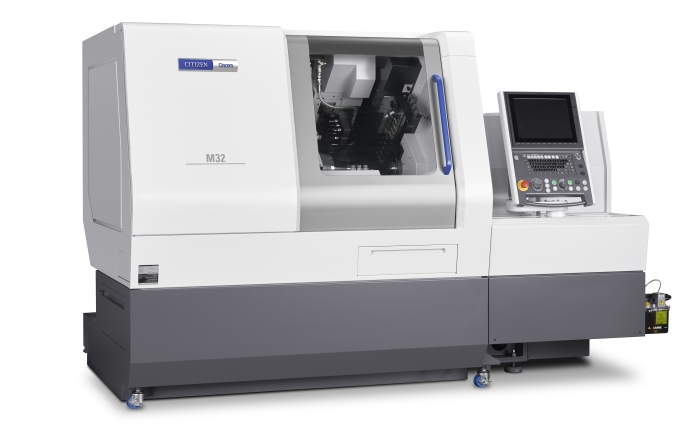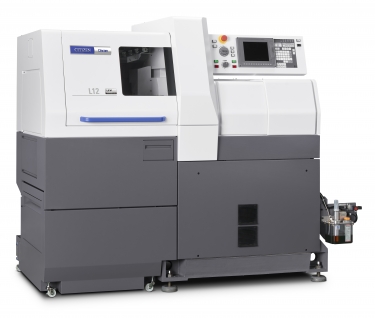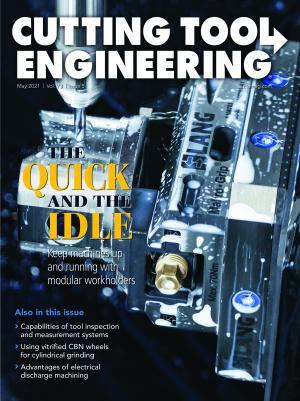A pair of the latest offerings from a company with a watchmaking background are good for a lot more than machining watch parts.
Capable of precise cutting, these state-of-the-art Swiss-style lathes are sold by Marubeni Citizen-Cincom Inc. in Allendale, New Jersey. One of the lathes, the M532 VIII, is the newest version of the Citizen Cincom M series turret-style Swiss turning center. The base M532 model can handle bar diameters up to 32 mm (1.26"), but its capacity can be increased to 38 mm (1.5") with the addition of an upgrade kit, which includes sleeves and a different guide bushing unit.
“You purchase this kit instead of buying another larger machine to run that one stray job” that requires a greater capacity, said Rich Miller, North Central regional sales manager.
He said an upgrade kit ranges from roughly $10,000 to $20,000.

The M532 VIII turret-style Swiss turning center can handle bar diameters up to 32 mm. Image courtesy of Marubeni Citizen-Cincom
The half-index capability of the M532’s 10-station turret allows a total of 20 positions. The turret features a tang drive that replaces the bevel gears that turn tools in older M models. By turning just the one tool doing the cutting at any one time rather than all the tools in the turret, the tang drive enables more torque to be allocated to the cutting tool in use, Miller explained. In addition, he said turning only one tool at a time reduces wear, as well as heat generated during the machining process.
The M532 offers 12 cutting axes, including a b-axis for angular drilling and contour milling. The machine also features a larger door area than older M machines, he said, which makes it easier for users to change tools and inserts.
The other addition to Marubeni Citizen-Cincom’s lathe lineup is the new-generation Cincom L212X featuring the all-axis simultaneous Cincom System M70 control, as well as a 15,000 rpm main spindle. The back spindle of the machine has a y2-axis that expands the range of usable tools.
“In the initial version of the L12, the tools for the back spindle cannot move up and down in Y, which limits what you can do on a subspindle,” Miller said. “But having a y-axis allows cross drills, slotting and many other things on the back side.”
Additionally, he said a change in the back spindle motor has increased the maximum speed of this spindle from 10,000 rpm to 12,000 rpm. The new motor also has more torque than its predecessor, resulting in shortened spindle acceleration and deceleration times, he said.

The back spindle of the Cincom L212X has a y2-axis that allows the use of more tools and operations. Image courtesy of Marubeni Citizen-Cincom
Both the M532 and L212X are programmed using Citizen’s editing function, which is designed to simplify complex jobs that involve both machine spindles working simultaneously.
“Citizen put lots of effort into their controls so users can easily program difficult moves just with the editing software,” which is simple G code, Miller said.
Citizen started making machines to produce its own watch parts and later began selling its machines to others. Today, machines like the M532 and L212X still are used to make watch parts, he said. But the main applications for these machines are in the medical industry.
“In the medical (field),” Miller said, “you have long, skinny parts and tiny parts being made that are hard to generate on normal two-axis CNC machines.”
He has customers in the automotive, hydraulics and semiconductor industries as well. What they all have in common is a need to do precision machining.
Machines like the M532 and L212X “are not made for just hogging material and what a simple two-axis lathe can do,” Miller said. “For the most part, when people come in, it means they are looking to generate parts that are very
accurate.”
Contact Details
Related Glossary Terms
- bushing
bushing
Cylindrical sleeve, typically made from high-grade tool steel, inserted into a jig fixture to guide cutting tools. There are three main types: renewable, used in liners that in turn are installed in the jig; press-fit, installed directly in the jig for short production runs; and liner (or master), installed permanently in a jig to receive renewable bushing.
- computer numerical control ( CNC)
computer numerical control ( CNC)
Microprocessor-based controller dedicated to a machine tool that permits the creation or modification of parts. Programmed numerical control activates the machine’s servos and spindle drives and controls the various machining operations. See DNC, direct numerical control; NC, numerical control.
- gang cutting ( milling)
gang cutting ( milling)
Machining with several cutters mounted on a single arbor, generally for simultaneous cutting.
- lathe
lathe
Turning machine capable of sawing, milling, grinding, gear-cutting, drilling, reaming, boring, threading, facing, chamfering, grooving, knurling, spinning, parting, necking, taper-cutting, and cam- and eccentric-cutting, as well as step- and straight-turning. Comes in a variety of forms, ranging from manual to semiautomatic to fully automatic, with major types being engine lathes, turning and contouring lathes, turret lathes and numerical-control lathes. The engine lathe consists of a headstock and spindle, tailstock, bed, carriage (complete with apron) and cross slides. Features include gear- (speed) and feed-selector levers, toolpost, compound rest, lead screw and reversing lead screw, threading dial and rapid-traverse lever. Special lathe types include through-the-spindle, camshaft and crankshaft, brake drum and rotor, spinning and gun-barrel machines. Toolroom and bench lathes are used for precision work; the former for tool-and-die work and similar tasks, the latter for small workpieces (instruments, watches), normally without a power feed. Models are typically designated according to their “swing,” or the largest-diameter workpiece that can be rotated; bed length, or the distance between centers; and horsepower generated. See turning machine.
- milling
milling
Machining operation in which metal or other material is removed by applying power to a rotating cutter. In vertical milling, the cutting tool is mounted vertically on the spindle. In horizontal milling, the cutting tool is mounted horizontally, either directly on the spindle or on an arbor. Horizontal milling is further broken down into conventional milling, where the cutter rotates opposite the direction of feed, or “up” into the workpiece; and climb milling, where the cutter rotates in the direction of feed, or “down” into the workpiece. Milling operations include plane or surface milling, endmilling, facemilling, angle milling, form milling and profiling.
- precision machining ( precision measurement)
precision machining ( precision measurement)
Machining and measuring to exacting standards. Four basic considerations are: dimensions, or geometrical characteristics such as lengths, angles and diameters of which the sizes are numerically specified; limits, or the maximum and minimum sizes permissible for a specified dimension; tolerances, or the total permissible variations in size; and allowances, or the prescribed differences in dimensions between mating parts.
- slotting
slotting
Machining, normally milling, that creates slots, grooves and similar recesses in workpieces, including T-slots and dovetails.
- tang
tang
Extended flat portion of tapered drill shank, endmill or other tool that allows maximum power transmission and proper positioning of the tool. Reverse shape of the machine-spindle slot into which it fits.
- turning
turning
Workpiece is held in a chuck, mounted on a face plate or secured between centers and rotated while a cutting tool, normally a single-point tool, is fed into it along its periphery or across its end or face. Takes the form of straight turning (cutting along the periphery of the workpiece); taper turning (creating a taper); step turning (turning different-size diameters on the same work); chamfering (beveling an edge or shoulder); facing (cutting on an end); turning threads (usually external but can be internal); roughing (high-volume metal removal); and finishing (final light cuts). Performed on lathes, turning centers, chucking machines, automatic screw machines and similar machines.









